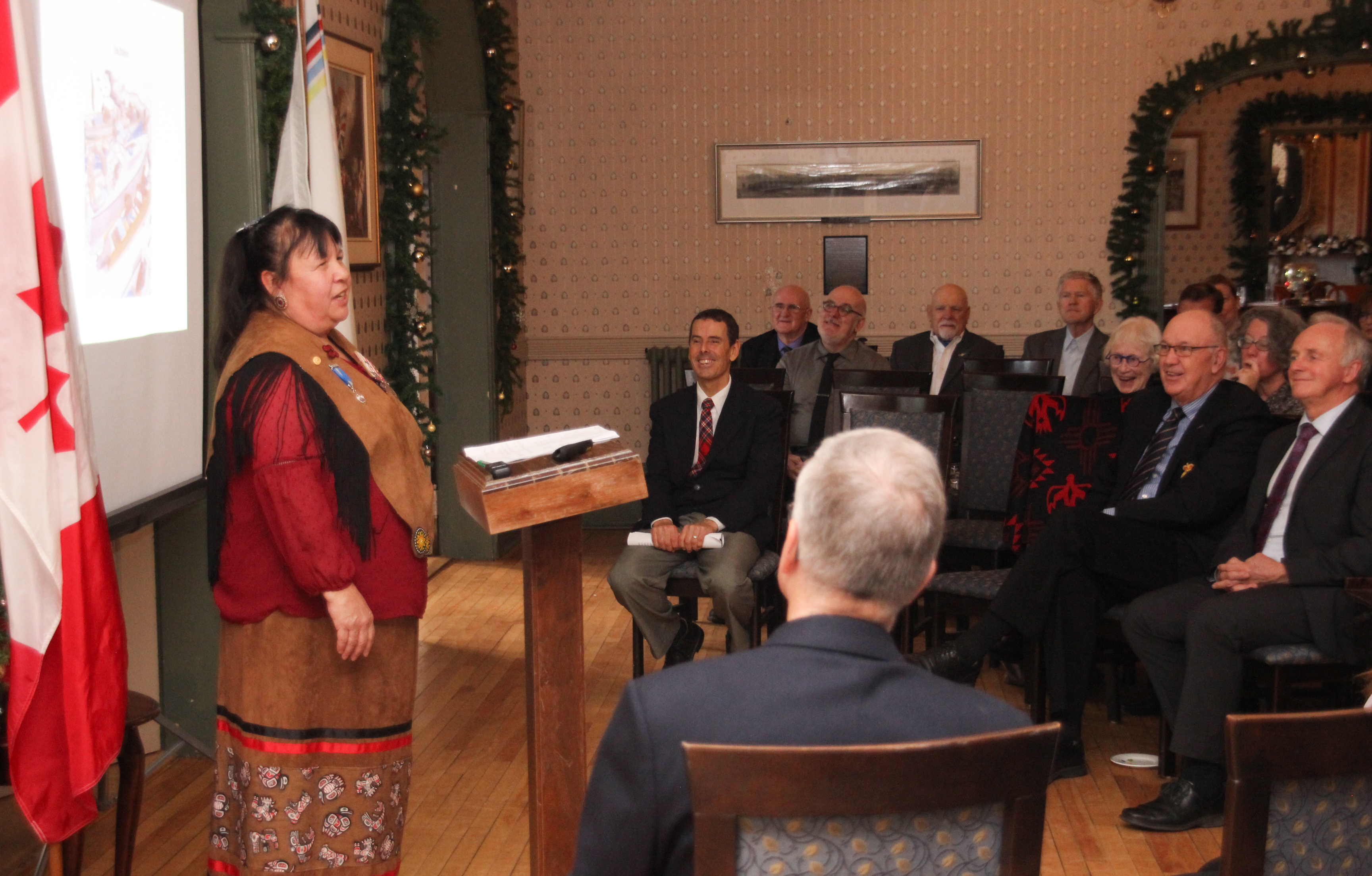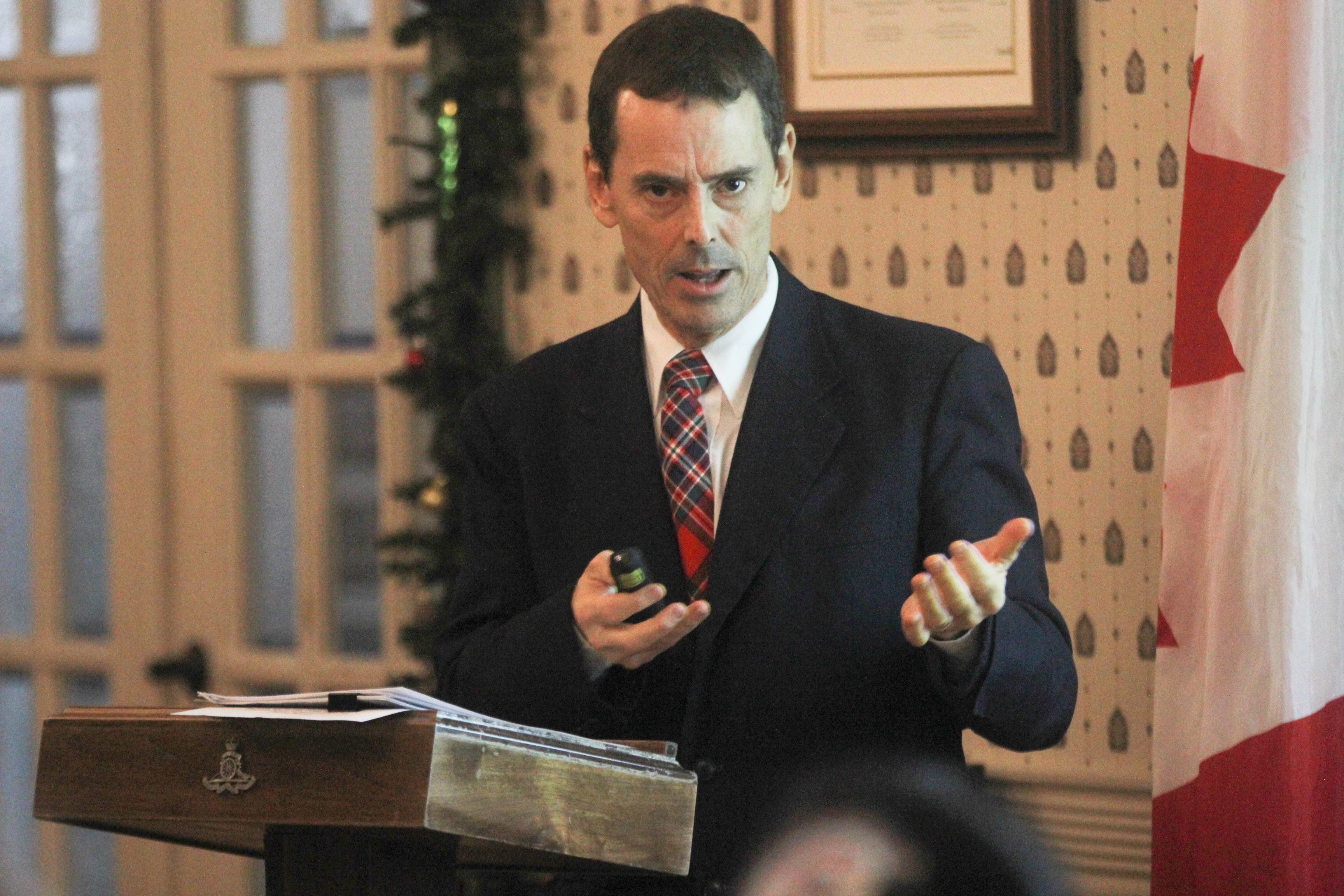
RYAN MELANSON, TRIDENT STAFF
Historian highlights contributions of Indigenous CAF members
By Ryan Melanson,
Trident Staff
The relationship between Canada’s Indigenous people and its Armed Forces has not always been a smooth one, beginning with the First World War, when about 4,000 Status Indians fought through obstacles to sign up for military service to Canada.

RYAN MELANSON, TRIDENT STAFF
But despite a history that includes barriers to entry, racism within the service, and other dark spots, 100 years on, the impact and cultural contributions of Indigenous members to the CAF as a whole have been significant and overwhelmingly positive. That’s the message historian John MacFarlane of DND’s Directorate of History and Heritage hoped to project during a recent presentation to the Royal United Services Institute of Nova Scotia.
“A theme I’m trying to get across with my work is that diversity is strength,” he said.
“Today, Indigenous people are welcomed into our Forces, and their cultural heritage has not only been appreciated and accepted, it has also significantly transformed the Canadian military.”
Through his work with the Directorate, MacFarlane has interviewed 70 Aboriginal veterans about their CAF experiences, and peppered anecdotes from those interviews throughout his presentation, while also highlighting the institutional shifts over the years, such as the hair policy regarding braids, meant to accommodate Indigenous personnel.
Regarding the First World War, he referenced testimony from veterans that they enjoyed the equality and camaraderie with their white colleagues, but did not enjoy that same sense of equality upon returning home, and fought for changes to the Indian Act.
“They were also joined by some of the white veterans in that push, because they served with those aboriginal veterans and considered them their equals,” MacFarlane said.
He also noted that the cultural knowledge of nature, rifles, and hunting was a benefit for Aboriginal soldiers, and those who served alongside them, in the First and Second World Wars. He also referenced an anecdote from veteran Stephen Simon of Big Cove New Brunswick, who helped his colleagues during a field training exercise in 1955, erecting a teepee, boiling water and catching a rabbit after instructors had taken away all of their kit. Survival tactics with Indigenous origins have in fact often been adopted by the military, with a recent example involving Canadian Rangers in a rescue operation after the 1999 avalanche in Kangiqsualujjuaq, Québec.
Unfortunately, MacFarlane’s research shows that veterans who served from 1968 to the present are more likely to speak about discrimination during their service, though they are also the group who have successfully fought for changes on that front and have been more likely to emphasize their Indigenous culture as part of their career.
Modern changes like the creation of the Defence Aboriginal Advisory Groups, and training programs like the CF Aboriginal Entry Program, Black Bear, and Raven programs, along with a greater emphasis on promoting diversity in the CAF and weeding out discrimination at all levels, have helped move the needle.
“The Canadian military has learned, over the past century, that while a great deal of conformity is essential for efficient military training and operations in most situations, there are occasions when a certain amount of accommodation for individuals or cultural groups is appropriate and beneficial,” he said, while noting much room remains for improvements and further change.
The audience also heard from CPO2 (Ret’d) Debbie Eisan, an Ojibway woman and former supply tech who has now become an advocate for Indigenous CAF members and a frequent presence at local military ceremonies and events. She was most recently on hand to perform a smudging ceremony at the naming event for the future HMCS Harry DeWolf. CPO2 (Ret’d) Eisan is also an elder with Halifax’s Mi’kmaq Native Friendship Centre.
She said she found a lot to relate to in MacFarlane’s presentation, from examples of discrimination and ignorance like the ones she dealt with early in her career, to anecdotes that describe the sense of pride that comes with service, and the desire to blend aspects of her traditional culture into the military lifestyle. One of her main contributions on that front, along with being involved in the aforementioned entry and training programs, was helping to develop the CAF Eagle Staff, along with others like Sgt. Tony Parsons and PO2(Ret’d) Chris Innis.
“This was a dream we had as a way to unite these people together, our Aboriginal soldiers, sailors and air personnel,” she said. The staff, originally held by MARLANT and now housed in Ottawa, has a dual purpose – it honours the service and sacrifice of Aboriginal veterans from the past, while emboldening those Indigenous members who wear the uniform today.
In her current role as an elder and advocate, CPO2(Ret’d) Eisan speaks of ‘teachable moments,’ when discussing the racism and discrimination that still exists within the CAF, just as it does within Canada as a whole.
“If I hear somebody saying something that is out of line, or if they’re spreading wrong information, or using the wrong terminology, i’ll make that a teachable moment. It doesn’t matter where I am,” she said, adding she doesn’t hesitate to offer corrections or education to Generals or Admirals if required.
“You can do this while being very respectful. For me, it’s all about teaching our culture, our spirituality, our traditions and our customs. That’s how we make progress.”






